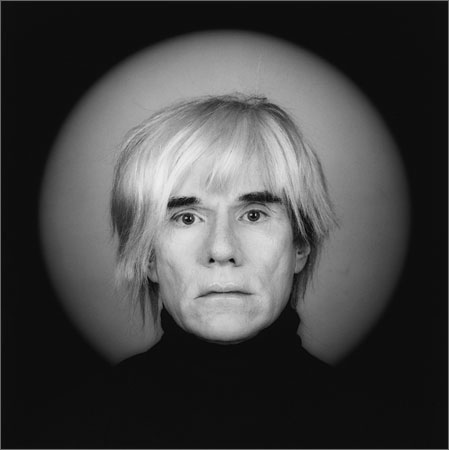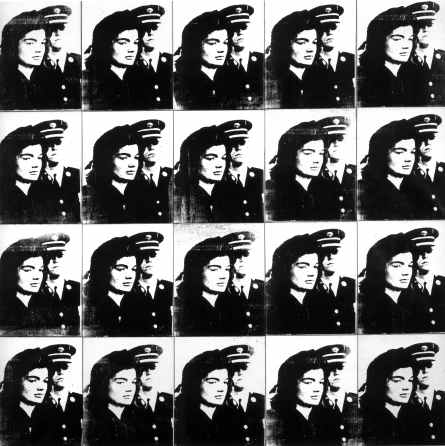 Andy Warhol was born in August 6, 1928 in Forest City, Pennsylvania. His real name was Andrew Warhola. During his teenage years his family moved to Pittsburgh, where he suffered from several nervous breakdowns. He graduated from Carnegie Institute of Technology, where he majored in pictorial design. Shortly after graduation, he found work in New York as an illustrator and advertiser for retail stores, greeting cards, and book covers. He became a very successful artist, winning many awards and distinctions.
Andy Warhol was born in August 6, 1928 in Forest City, Pennsylvania. His real name was Andrew Warhola. During his teenage years his family moved to Pittsburgh, where he suffered from several nervous breakdowns. He graduated from Carnegie Institute of Technology, where he majored in pictorial design. Shortly after graduation, he found work in New York as an illustrator and advertiser for retail stores, greeting cards, and book covers. He became a very successful artist, winning many awards and distinctions.
In the 1960’s, he began painting and was very successful. He was a very eccentric person. He would dye his hair silver and was best known for wearing wigs. One thing that possibly contributed to Warhol’s work was his sexuality. Much of his early work was actually rejected for being openly gay. Many of his pieces focus and center on the nude male figure. Warhol was frequently questioned about how this affected him and his work. He claimed that at a certain point all he could do was stop caring what people thought and said about him. Another would be his religion; Andy Warhol was a Byzantine Catholic. He described himself as a religious person and often did charity work on behalf of the church. He could be seen at the church nearly daily and frequently attended Mass. His religion played a large role in some of his work, especially some of his later pieces. His brother claimed that he kept his religious beliefs to himself because he felt they were private and people didn’t need to know. Warhol even funded his nephew’s way through school to become a priest.
Warhol has several works that are still considered icons. He is best known for his painting of a Campbell Soup can (see figure 1) and one of Marilyn Monroe; a couple of his works are titled “Gun” (see figure 2), and “Twenty Jackies” (see figure 3). He also became a music producer and began directing films. In June 1968, he was shot by a fan and spent two months recovering in a hospital. After the shooting he no longer made films, but he continued with his art. In the 1970’s and 1980’s, Andy Warhol’s popularity increased, which he used to the advantage of helping other artists.
Warhol died in his sleep in New York City on February 22, 1987 while recovering from a routine gallbladder surgery. The cause of his death was a sudden post-operative cardiac arrhythmia. Warhol had actually put off having the procedure because he was afraid of hospitals and doctors. The New York Hospital was sued by the Warhol family; they claimed his death was caused by hyperhyrdation and improper care. His funeral was held at the Holy Ghost Byzantine Catholic Church in Pittsburgh, Pennsylvania. In his will, he ordered that his entire estate (besides a few things for his family) be used to start a foundation to enhance the visual arts. The auction of all his belongings took around 9 days to complete and brought in upwards of $20 million. The money was used to create the Andy Warhol Foundation for the Visual Arts. This foundation still serves as the official estate of Warhol.
He first exhibited in an art gallery in 1962, when the Ferus Gallery in Los Angeles showed his 32 Campbell's Soup Cans, 1961-62. They are about sameness (though with different labels): same brand, same size, same paint surface, same fame as product. They mimic the condition of mass advertising, out of which his sensibility had grown.
(Figure 2)
"Gun" by Andy Warhol is a unique piece due to the fact that putting an artistic impression on a weapon alone can be challenging. Warhol dared to be different by incorporating everyday objects into numerous paintings and putting his own flare on them. I believe this is a significant piece due to the daunting task of making a weapon an art piece, much less with only shades of black and gray. The seamless transition from the background to the handle of the gun is one of its own. He is able to let the gun stand out on its own while incorporating the background with a smooth transition. He is also able to incorporate a light effect by lightening up the vertical portion of the barrel and revolver. The handle is shown as a wood grain pattern as the rest takes on a metal look. Warhol used significant amount of detail on the small features to represent a picture rather than a painting. This is only but one of Warhol's gun paintings which were a product of a near death experience by a gun shot. It is almost as though he attempts to create a real life visual of what he endured through making the gun appear dangerous. No ambiguous representations of guns were used as the gun appears life like.Painted in 1964, Twenty Jackies portrays the sorrow and emotional tragedy that Jackie Kennedy suffered through when her husband, President John F. Kennedy, was assassinated in 1963. Andy Warhol was not bothered so much by the tragic event; instead, he was upset by the media’s forced grief and sadness on the American people. To him, this portrait displayed the real tragedy that had occurred. Warhol chose this image of Jackie to express a sense of nationality and to capture the widow’s heartache at her husband’s funeral, as she took on her own sorrow, as well as the nation’s burden. The repetition of the same image twenty times reflects the emphasis and insistence of the media. No one could escape hearing about the assassination; the news was everywhere. Warhol’s technique instead captured the true pain and emotion that one single person experienced, rather than what the media imposed on the nation as a whole. This painting supports Andy Warhol’s reputation of portraying an American icon, while expressing emotion and significance through repetition and detail. The lack of his characteristic colors in this painting represents the sadness and grief of the First Lady.




